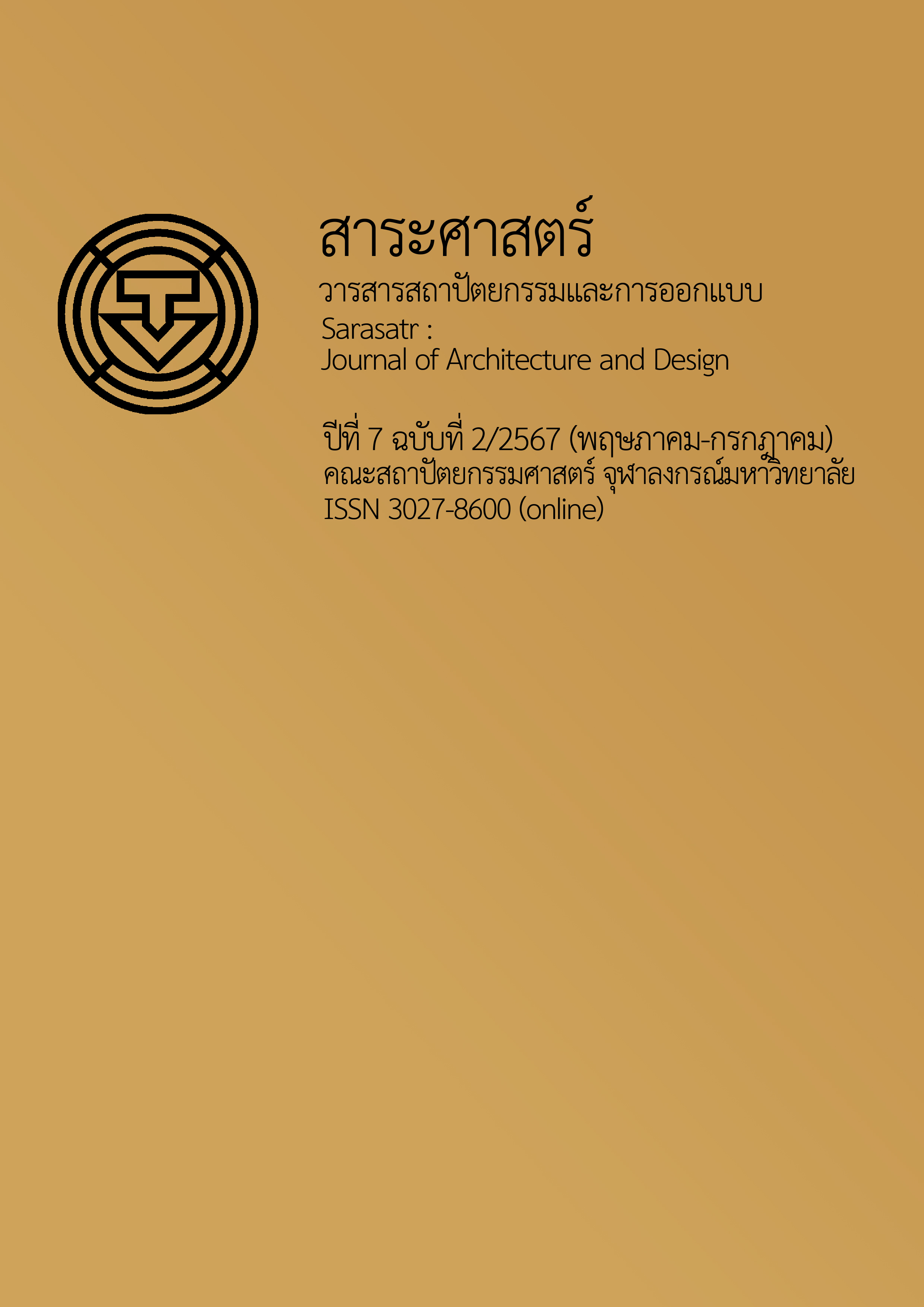การใช้งานสกู๊ตเตอร์ไฟฟ้าแบบเช่าในระบบปิด กรณีศึกษาจุฬาลงกรณ์มหาวิทยาลัย
Main Article Content
บทคัดย่อ
สกู๊ตเตอร์ไฟฟ้าแบบเช่าเริ่มมีการใช้บริการเป็นจำนวนมากทั้งในยุโรป อเมริกา และเอเชีย ประเทศไทยเริ่มมีการให้บริการเช่าสกู๊ตเตอร์ไฟฟ้าตั้งแต่ พ.ศ. 2561 และมีแนวโน้มในการเปิดพื้นที่ให้บริการเพิ่มขึ้นในพื้นที่ระบบปิดโดยเฉพาะในพื้นที่มหาวิทยาลัย ในขณะเดียวกันก็ยังไม่มีกฎหมายที่เกี่ยวข้องมารองรับการใช้งานสกู๊ตเตอร์ไฟฟ้า ดังนั้นการใช้งานสกู๊ตเตอร์ไฟฟ้าในพื้นที่สาธารณะจึงยังไม่มีการควบคุมให้มีการใช้งานอย่างเหมาะสม งานวิจัยนี้มีเป้าหมายเพื่อศึกษาการใช้งานสกู๊ตเตอร์ไฟฟ้าแบบเช่าในระบบปิดภายในจุฬาลงกรณ์มหาวิทยาลัยเป็นกรณีศึกษา เนื่องจากมีการให้บริการสกู๊ตเตอร์ไฟฟ้าแบบเช่าต่อเนื่องมาตั้งแต่ พ.ศ. 2565 และมีจำนวนผู้ใช้งานอย่างต่อเนื่องเมื่อเทียบกับพื้นที่อื่น โดยแบ่งพื้นที่ศึกษาเป็น 3 เขตพื้นที่ตามลักษณะทางกายภาพซึ่งมีโครงข่ายถนนสายหลักผ่านกลางพื้นที่ศึกษา ได้แก่ 1) เขตการศึกษาฝั่งหอประชุม 2) เขตการศึกษาฝั่งอาคารบริหารและหอพัก และ 3) เขตพาณิชยกรรมสามย่านและพื้นที่ต่อเนื่อง การศึกษาครั้งนี้ต้องการวิเคราะห์ความสัมพันธ์ระหว่างลักษณะทางกายภาพของพื้นที่ที่มีต่อพฤติกรรมการใช้งานสกู๊ตเตอร์ไฟฟ้าแบบเช่า ด้วยการรวบรวมข้อมูลจากผู้ให้บริการ การสำรวจกายภาพพื้นที่ และการสำรวจพฤติกรรมการใช้งานด้วยแบบสอบถาม ได้แก่ เส้นทางการใช้งาน ทางเลือกการข้าม และจำนวนผู้ใช้งานในแต่ละเขตพื้นที่ ผลการศึกษา พบว่า เส้นทางการใช้งานสกู๊ตเตอร์ไฟฟ้ามีการเลือกใช้เส้นทางจักรยานมากที่สุดทั้งในพื้นที่ระบบปิดและพื้นที่สาธารณะ ในขณะที่มีการใช้งานบนถนนใกล้เคียงกันภายในพื้นที่แบบระบบปิด แต่มีการเลือกใช้งานทางเท้าน้อยอย่างมีนัยสำคัญทางสถิติ ในด้านของการข้ามทางสาธารณะนั้นผู้ใช้งานสกู๊ตเตอร์ไฟฟ้ามีความต้องการที่จะข้ามเขตทางสาธารณะแม้ว่าในทางกฎหมายจะไม่สามารถทำได้ และเลือกข้ามด้วยวิธีที่สะดวกมากกว่าวิธีที่ปลอดภัย และสุดท้ายในด้านของจำนวนผู้ใช้งานในแต่ละเขตพื้นที่นั้นไม่ได้ขึ้นอยู่กับว่า เป็นพื้นที่ระบบปิด หรือพื้นที่สาธารณะ แต่ในเขตพื้นที่ที่มีรูปแบบการใช้งานอาคารประเภทพื้นที่ส่วนกลางและที่อยู่อาศัยจะส่งผลให้มีแนวโน้มผู้ใช้งานสกู๊ตเตอร์ไฟฟ้าในพื้นที่นั้นเพิ่มขึ้น
Article Details
เอกสารอ้างอิง
ธรรญรธ พะกะยะ และอัจฉราพร สีหวัฒนะ. (2566, กันยายน-ธันวาคม ). มาตรการทางกฎหมายในการกำกับดูแลยานพาหนะไฟฟ้าขนาดเล็กในประเทศไทย กรณีศึกษาเฉพาะสกู๊ตเตอร์ไฟฟ้า. วารสารศึกษิตาลัย, 4(3). https://so01.tci-thaijo.org/index.php/SJ/article/view/270035
ปรัตถกร กษิรวัฒน์. (2563). การพัฒนาดัชนีความเหมาะสมทางกายภาพของการใช้งานสกู๊ตเตอร์ไฟฟ้าบนถนนในเมือง [วิทยานิพนธ์ปริญญามหาบัณฑิต, จุฬาลงกรณ์มหาวิทยาลัย]. CUIR. https://cuir.car.chula.ac.th/bitstream/123456789/77198/1/6170465421.pdf
รัฐพล ทองแป้น. (2566). การเปลี่ยนแปลงพฤติกรรมการเดินทางจากการใช้สกู๊ตเตอร์ไฟฟ้าร่วมกันในจุฬาลงกรณ์มหาวิทยาลัย [วิทยานิพนธ์ปริญญามหาบัณฑิต, จุฬาลงกรณ์มหาวิทยาลัย]. CUIR. https://cuir.car.chula.ac.th/handle/123456789/84468
Bai, S., & Jiao, J. (2020, July). Dockless e-scooter usage patterns and urban built environments: A comparison study of Austin, TX, and Minneapolis, MN. Travel Behaviour and Society,20, 264-272. https://doi.org/10.1016/j.tbs.2020.04.005
CB Insights. (2021). The micromobility revolution: How bikes and scooters are shaking up urban transport worldwide. https://www.cbinsights.com/research/report/micromobility-revolution/
Göran, S. (2020). Making mobility as a service: Towards governance principles and pathways [Doctoral dissertation, Chalmers University of Technology]. ResearchGate. https://www.researchgate.net/publication/341179834_Making_Mobility-as-a-Service_Towards_Governance_Principles_and_Pathways
Jinghai, H., Hongtai, Y., Chaojing, L., Rong, Z., Linchuan, Y., & Yi, W. (2021, May). Influence of the built environment on e-scooter sharing ridership: A tale of five cities. Journal of Transport Geography, 93, 103084. https://doi.org/10.1016/j.jtrangeo.2021.103084
Mayhew, L. J., & Bergin, C. (2019, April 11). Impact of e‐scooter injuries on emergency department imaging. Journal of Medical Imaging and Radiation Oncology, 63, 461-466. https://doi.org/10.1111/1754-9485.12889
Meyer, M. D., & Miller, E. (2001). Urban transportation planning: A decision-oriented approach (2nd ed.). McGraw-Hill. https://www.researchgate.net/publication/235363396_Urban_Transportation_Planning_A_Decision-Oriented_Approach/citations
Paudel, M., & Fah Yap, F. (2021). Front steering design guidelines formulation for e-scooters considering the influence of sitting and standing riders on self-stability and safety performance. Proceedings of the Institution of Mechanical Engineers, Part D: Journal of Automobile Engineering, 235(9). https://doi.org/10.1177/0954407021992176
Phithakkitnukooon, S., Patanukhom, K., & Demissie, M. G. (2021). Predicting spatiotemporal demand of dockless e-scooter sharing services with a masked fully convolutional network. ISPRS International Journal of Geo-Information 2021, 10(11), 773. https://doi.org/10.3390/ijgi10110773
SAE International Recommended Practice. (2019). Taxonomy and classification of powered micromobility vehicles. SAE International. https://doi.org/https://doi.org/10.4271/J3194_201911
Verkehrswende, A. (2019). Shared e-scooters: Paving the road ahead policy recommendations for local government.https://www.agora-verkehrswende.de/fileadmin/Projekte/2019/E-Tretroller_im_Stadtverkehr/Agora-Verkehrswende_Shared-E-Scooters-Paving-the-Road-Ahead_WEB.pdf
Wibowo, R. Y. (2022). Assessing the potential of developing an ecosystem for electric scooters in Bangkok, Thailand [Master’s thesis, Chulalongkorn University]. CUIR. https://cuir.car.chula.ac.th/handle/123456789/82794
Zhang, W., Buehler, R., Broaddus, A., & Sweeney, T. (2021). What type of infrastructures do e-scooter riders prefer? A route choice model. Transportation Research Part D Transport and Environment, 94, 102761. https://doi.org/10.1016/j.trd.2021.102761
Zuniga-Garcia, N., Juri, N. R., Perrine, K. A., & Machemehl, R. B. (2021). E-scooters in urban infrastructure: Understanding sidewalk, bike lane, and roadway usage from trajectory data. Case Studies on Transport Policy, 9(3), 983-994. https://doi.org/https://doi.org/10.1016/j.cstp.2021.04.004


